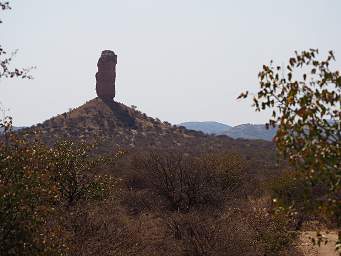
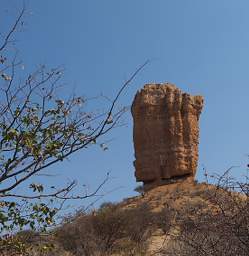
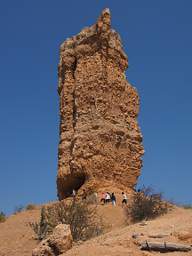
For the second leg of our World Teach volunteers' tour through Namibia, we left Etosha National Park and headed through Damaraland to the Skeleton Coast and the town of Swakopmund.
Once we were under way, I looked at the map and consulted our guidebook to see if there might be things we shouldn't miss along the way. We decided to stop at Vingerklip, a 30m high finger of rock reminenesant of geologic formations one sees in the Utah deserts. It remains because of its more durable capstone, a form of dolomite. The dolomite formation is more evident in the much larger mesa-like formations nearby; the whole area reminds one of Monument Valley.
We hiked up to the base of the Vingerklip, from which one gets a great view of the surrounding terrain. It's forbidden to climb the rock itself, but it's a sedimentary composite and not a particularly inviting thing to climb anyway. It would be a dicey proposition, crumbly rock where it's difficult to place protection.
 |
 |
 |
| Vingerklip | ||
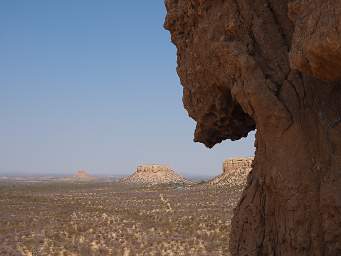 |
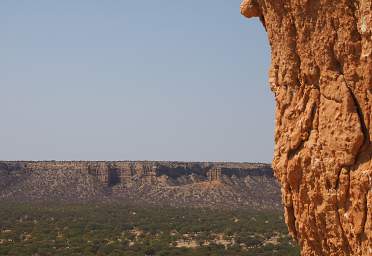 |
| Mesas near Vingerklip | |
There were some interesting voids in the rock around the Vingerklip, apparently the result of uneven erosion.
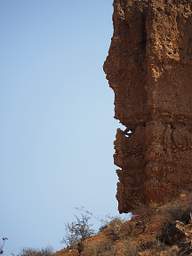 |
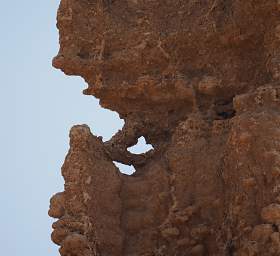 |
| Vingerklip | |
Damaraland is a harsh environment, mostly rock and scrub. The scrub is not gentle; like almost every native plant, most things have thorns. Because of the very dry climate, plants often don't have leaves and flowers or fruits at the same time. So you see what looks like dead trees with fruit on them.
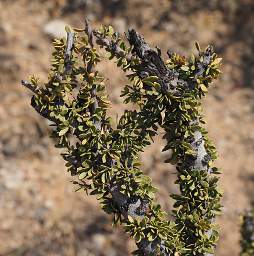 |
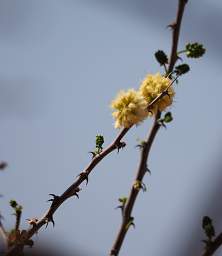 |
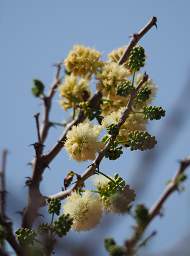 |
| Shrub | Flower Xxx Thorn Shrub | |
Afterwards we briefly visited the Vingerklip Lodge for some refreshments, then resumed our trip through Damaraland to the coast.
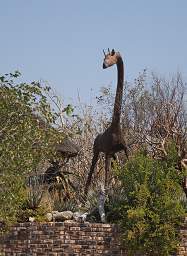 |
| Vingerklip Lodge Giraffe Statue |
We crossed the Ugab River, a dry bed with no water except for a few days a year. But there is clearly subterranean moisture, as the edges of the riverbed are dotted with trees.
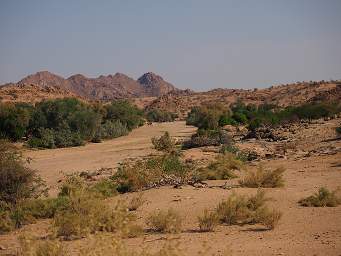 |
| Dry Ugab River |
We passed hardscrabble houses of the Damara people, an occasional goat or small herd of animals, and rusted out long abandoned car bodies.
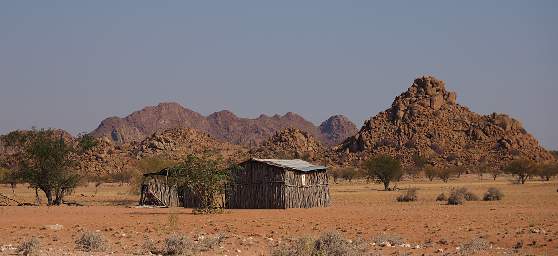 |
 |
| Damaraland | |
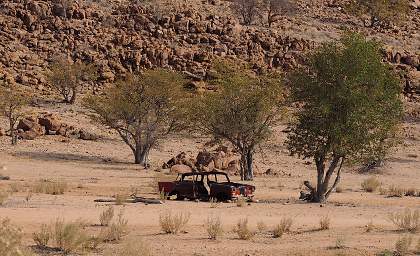 |
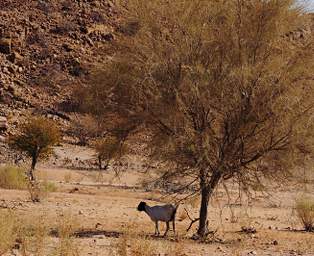 |
| Rusted Out Car | Goat |
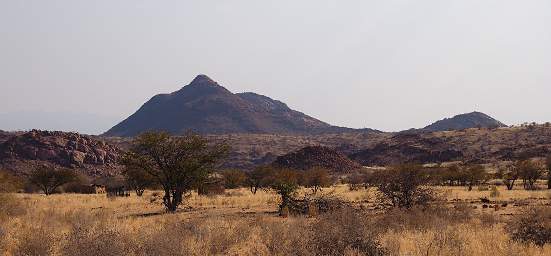 |
| Damaraland |
We did, however, eventually come to a larger metropolitan area with a shopping mall...
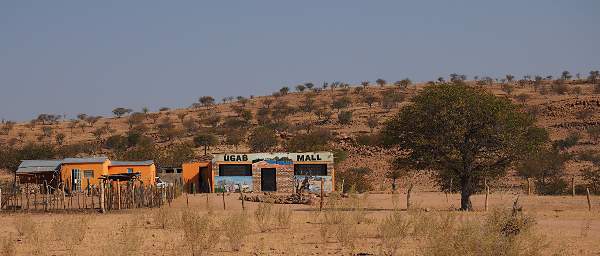 |
| Ugab Mall |
While northwestern Namibia has regions whose names seem to imply they are populated exclusively by one ethnic group, that is not the case. Kaokoland is nominally the land of the Himba; Damararland is nominally the land of the Damara; our school was in Ovamboland, nominally the land of the Owambo (Ovambo) people. But while those lands may hold a denser concentration of a particular people, today they are widely dispersed and intermixed within the regions. So while we were traveling through Damaraland, we saw Himba, Herero, and Damara people along the way.
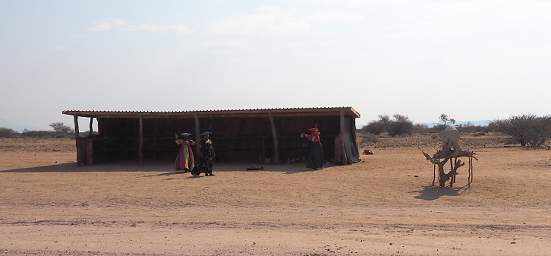 |
| Herero Women at a Roadside Stand |
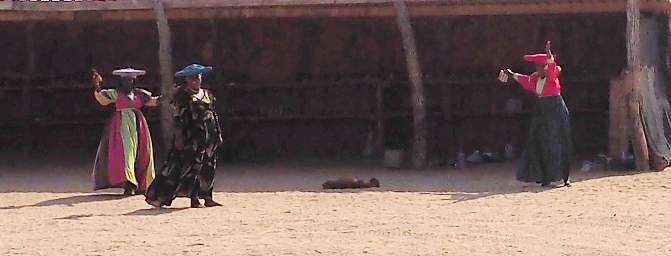 |
While Damaraland is rugged and rocky, it is also a land of grass. It's sparse bunchgrass, and can't withstand continual grazing very well; it's far better suited to the migrational grazing patterns of Namibia's native animals. This is pretty obvious by comparing places where there are permanent dwellings with those where there are not.
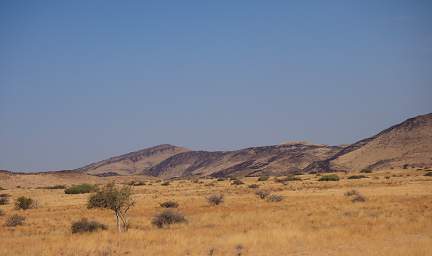 |
| Damaraland |
We passed by Brandberg Mountain, the tallest mountain in Namibia and an area containing thousands early rock art. Dona and I would return there later in our travels alone.
 |
| Swakop Brandberg Mtn |
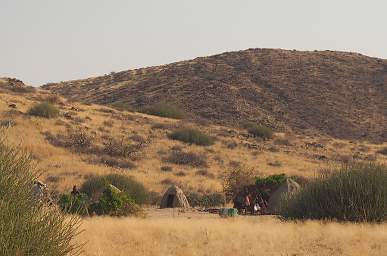 |
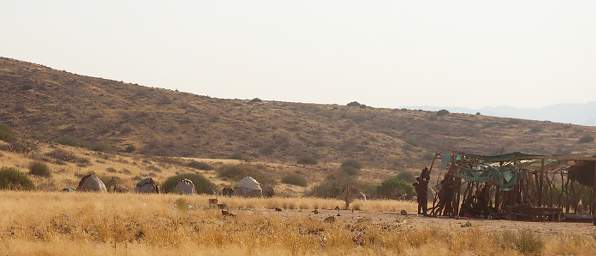 |
| Himba People in Damaraland | |
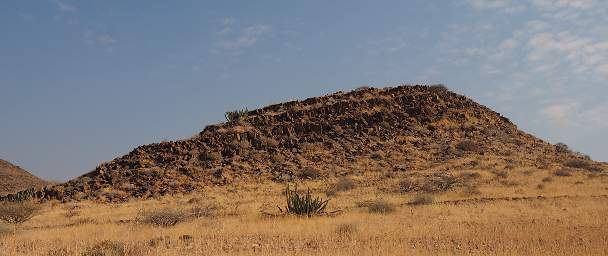 |
| Damaraland |
 |
| Roadside Stand |
I don't know if sand and heat are particularly hard on vehicles, but it seems like no matter where we were we came across rusted out car bodies. They made me think of broken down Conestoga Wagons in the American West in the 19th century.
 |
| Rusted Out Car |
As we left Damaraland and moved into the region of the Skeleton Coast, the landscape got even starker. But even there we came upon wildlife -- Ostriches.
 |
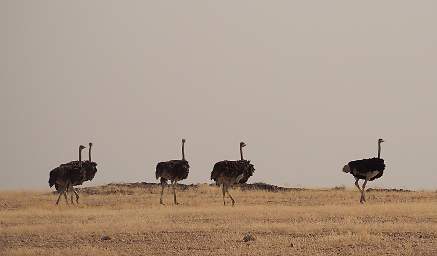 |
| Ostriches | |
We were traveling on a typical Namibian winter day, warm and clear, with no clouds in sight. It was hazy from dust, but as we neared the coast it turned overcast from the near constant fog that hugs the Atlantic Ocean - Africa boundary.
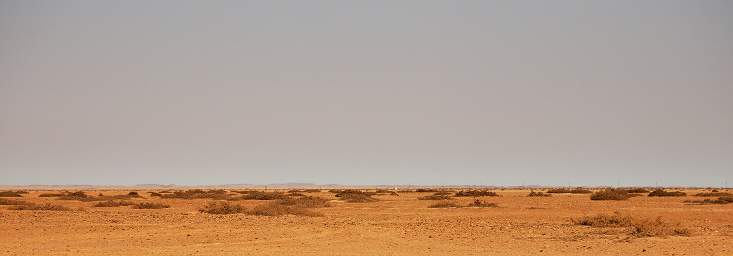 |
| Approaching the Coast north of Swakopmund |
 |
| Coast North of Swakopmund |
By the time we arrived in Henties Bay it felt like we were in the Pacific Northwest of the United States. It was foggy all the way down to Swakopmund. We set up camp at a nice campground close to the beach on the south end of town. No chance of sunshine, and we all wanted a campfire to warm up. We went out for pizza in Swakopmund, at a well-known place which turned out to have terrible service and food that wasn't particularly good.
We were all delighted, however, to learn that the campground had hot water showers that worked.
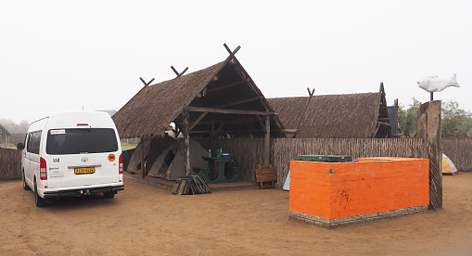 |
| Camp in Swakopmund |
There was a rubbish heap just over the fence from the campground, and it backed up to a small tidal marsh which had quite a few birds. Some of them would hop onto or over the fence.
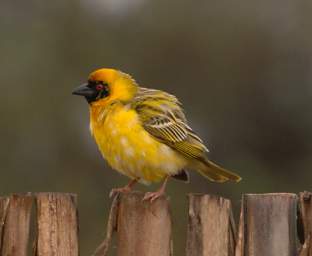 |
| Southern Masked Weaver |
The next day we headed south to a part of the coast with some nice sand dunes. We were going to "Dune 7", a well-known recreational site.
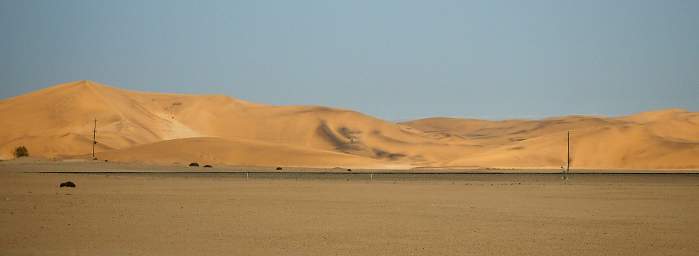 |
| On the Way to Dune 7 |
Dune 7 is a fair-sized hunk of sand. There's an admission fee, but other than that you're pretty much free to wander around. They also rent four-wheelers and other dune-related recreational toys. Our first order of business was to climb to the top.
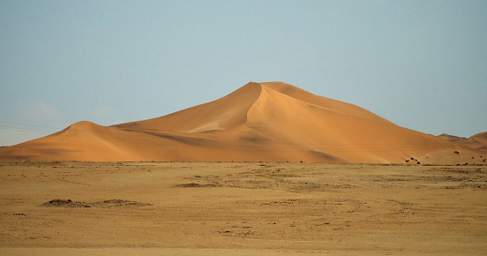 |
| Dune 7 |
Shawn and Kathryn decided on the direct approach...
 |
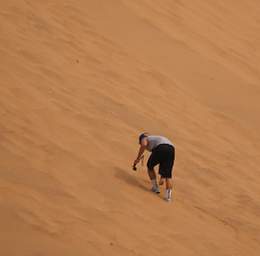 |
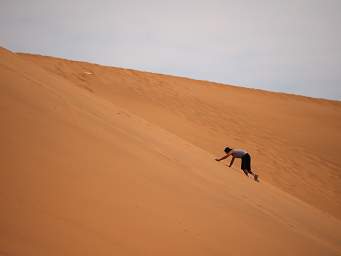 |
| Shawn on Dune 7 | ||
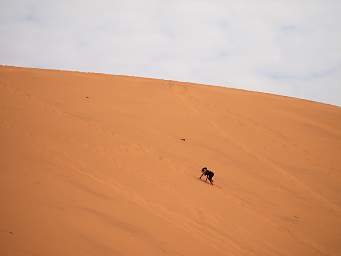 |
 |
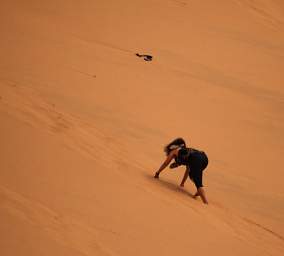 |
| Kathryn on Dune 7 | ||
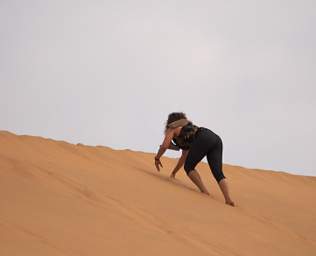 |
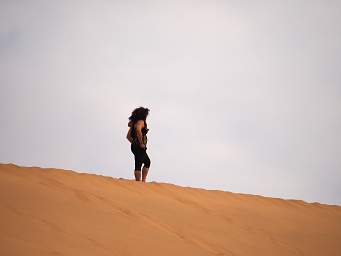 |
The rest of us took the easier way up, staying on the ridge.
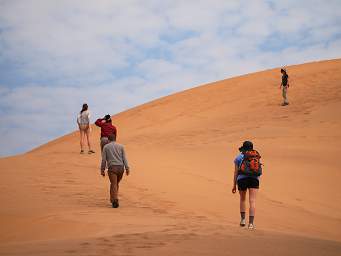 |
| The Rest of Us on Dune 7 |
 |
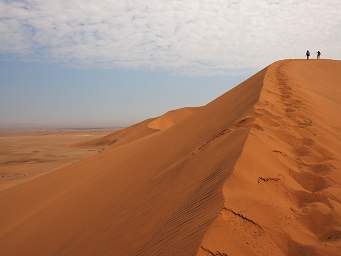 |
| Dune 7 | |
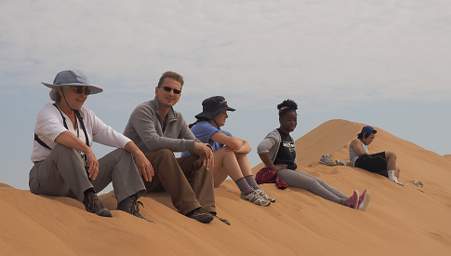 |
| Enjoying the View
Dona, Bret, Diane, Jessica and Shawn |
I discarded a few years and hopped, skipped and rolled part way down just for the hell of it.
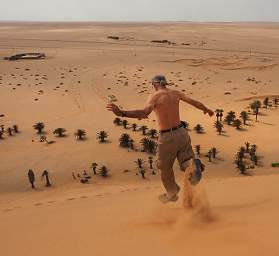 |
| Hopping, Skipping... |
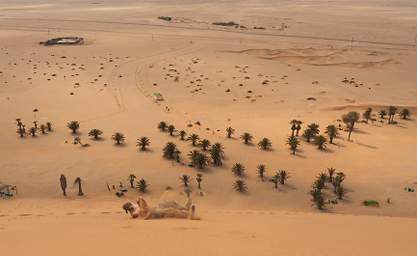 |
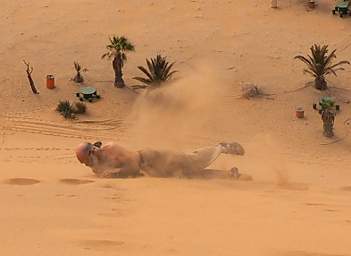 |
| ... and Rolling | |
 |
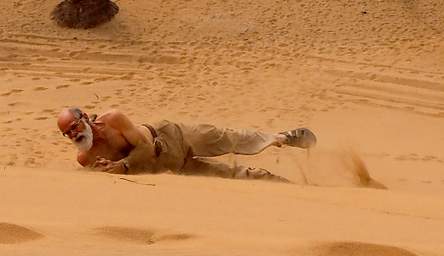 |
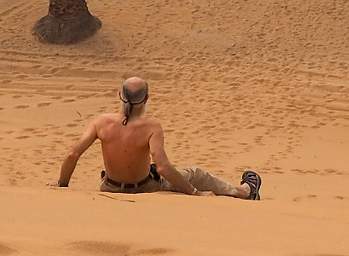 |
| It Took a Long Time for the Spinning and Dizziness to Stop |
 |
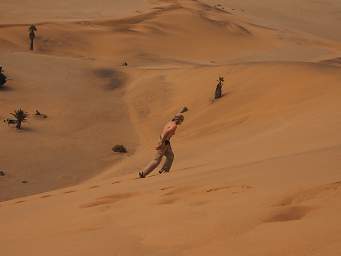 |
| Then the Climb Back Up
I was glad I only went part way down. |
|
Dona and I kept our eyes peeled for some of the unique animals which inhabit the harsh hot dry dune environment. We were rewarded with a few.
 |
| Shovel Snouted Lizard |
Eventually, we got to the top.
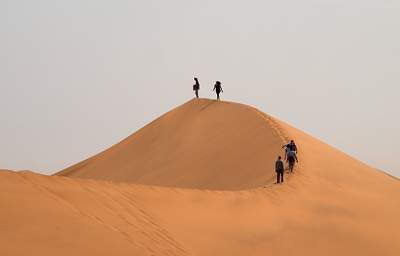 |
| Group Ariving at the Top |
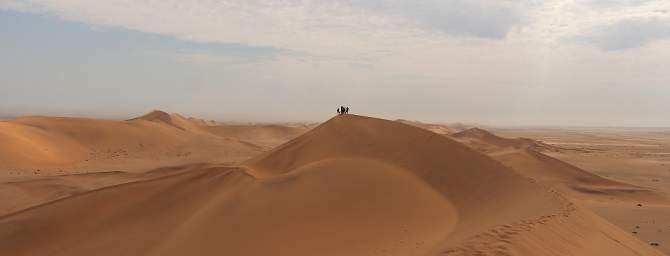 |
| Most of the Group On Top |
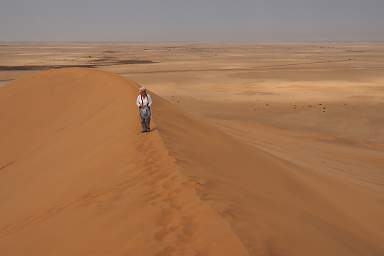 |
 |
| Dona on Dune 7 | |
 |
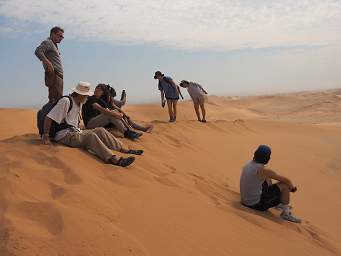 |
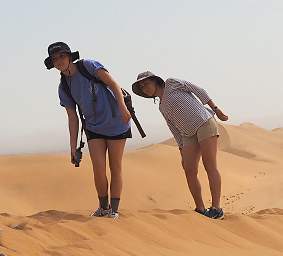 |
| Group on Top of Dune 7 | Diane and Katy | |
After the mandatory mug shots and selfies, we started the fun run down.
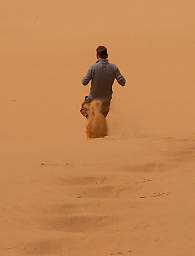 |
| Bret Going Down |
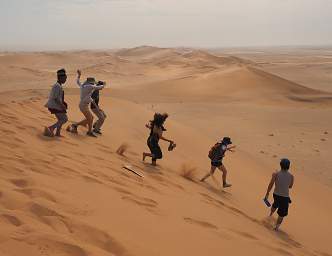 |
| The Group Starting Down |
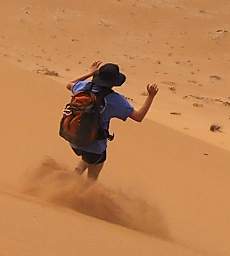 |
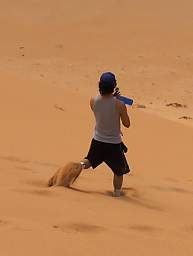 |
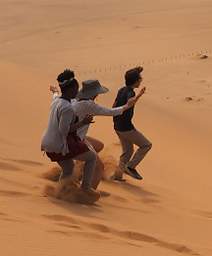 |
| Diane | Shawn | Jessica, Katy and Fletcher |
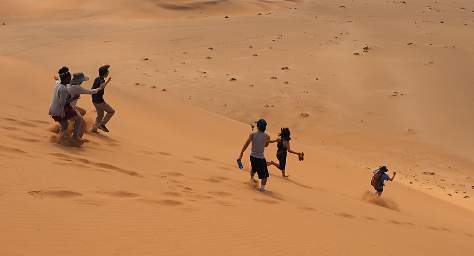 |
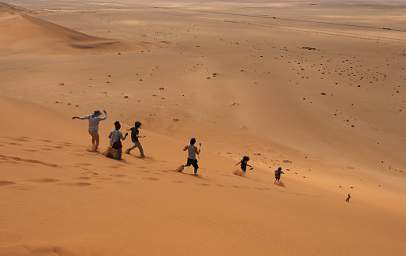 |
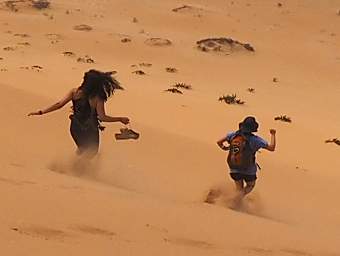 |
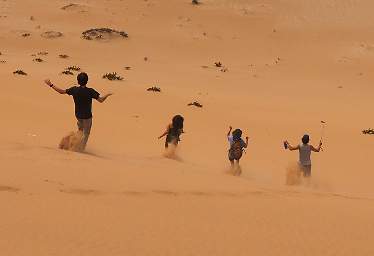 |
| Kathryn and Diane | Fletcher, Kathryn, Diane and Shawn |
 |
 |
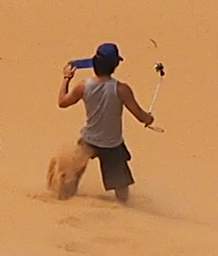 |
| Katy and Jessica | Shawn | |
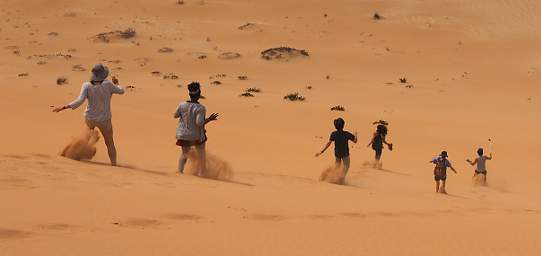 |
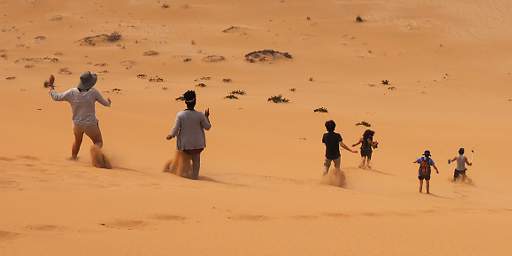 |
 |
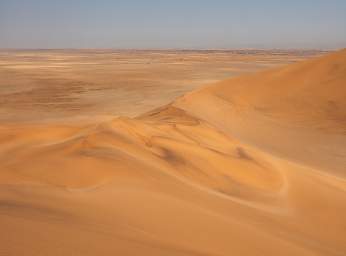 |
| Dune 7 |
Even out in this apparently barren landscape, things still grew. The adaptions to enable life on earth are amazing. Little Dollar Bushes grew here and there, gathering the sand around them and providing an obstacle to the wind where more sand could deposit, where it is ever-so-slightly cooler, and where a small amount more of moisture can condense.
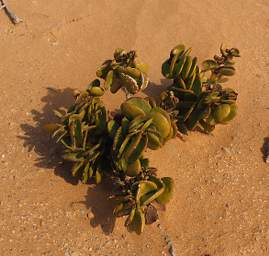 |
| Dollar Bush |
The whole time we were wandering around the Namib dessert we would keep our eyes peeled for beetles. Many of them have one of the coolest adaptions for gathering moisture and one human engineers have mimicked. Water condenses on their backs forming droplets, which then run down the surface to their mouths. The particular mechanism by which this occurs is still in debate and still being studied. At least one of the beetles actively fog basks by raising its rear end and lowering its head when conditions are suitable for collecting moisture. We did not observe this particular beetle, partly because we didn't have a proper idea of what it looks like...
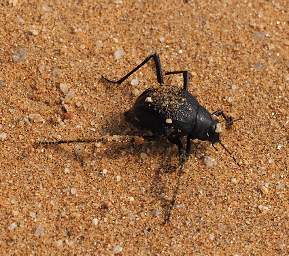 |
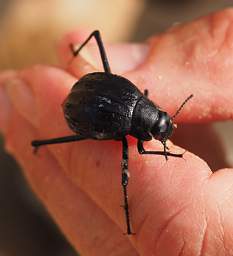 |
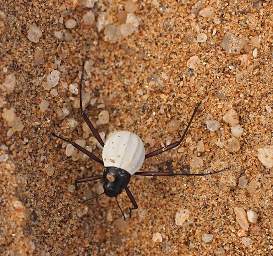 |
| All Black Beetle | Black and White Beetle | |
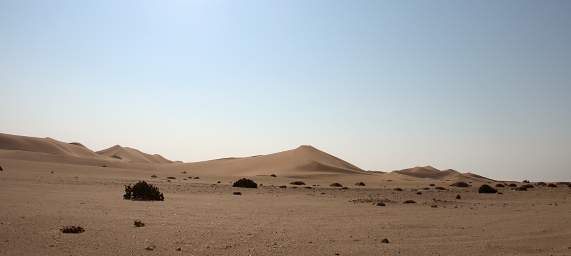 |
| Near Dune 7 |
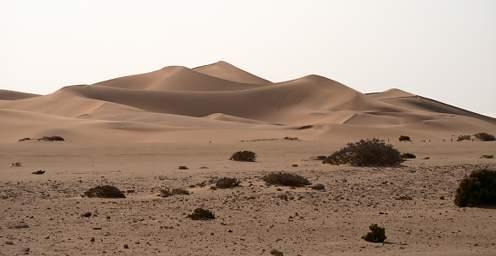 |
The next day dawned cool and foggy, the usual situation for coastal Namibia. We made french toast for breakfast and Kathryn learned how to flip them. French toast is probably a good way to learn how to flip things in a skillet, as the toast itself can't fly apart like a pancake...
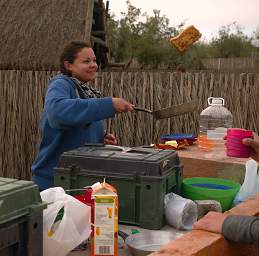 |
| Kathryn Flipping French Toast |
Dona and I spent the day wandering around, some of it at the mini-marsh / tidal area right behind camp. We saw quite a few different birds.
While on the beach at the tidal area we were approached by a white "neighborhood watch" type self-appointed security guard, who told us this was an unsafe place to be. We didn't feel at all unsafe; perhaps we were being naive, but he struck us as a paranoid white-supremasist type. While we were talking to him a black guy was walking along the beach a short distance away minding his own business, and without provocation the self-appointed guard accousted him and bullied him off. I was disgusted by the whole thing. Later on, Damaras, the former World Teach volunteer who had been traveling with us and who now lived in Swakopmund, told us that crime had gone down quite a bit since the neighborhood watch type guards had started patroling.
The housing area outside of Swakopmund where most of the poorer black people live, known as "The location," has no electricity or running water. I couldn't help but wonder how things might be different if people were provided with decent services and made to feel welcome. Swakopmund left both of us feeling like a piece of apartheid-era South Africa survived as an enclave in Namibia; we weren't impressed with it.
 |
 |
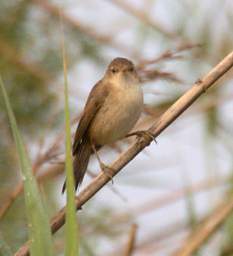 |
| Xxx Sunbird | African Red Eyed Bulbul | Bird Xxx |
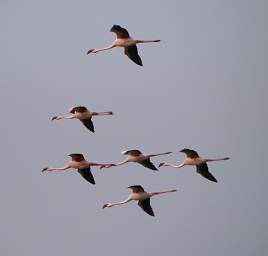 |
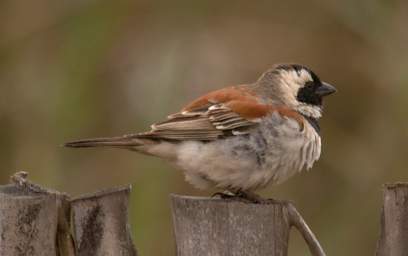 |
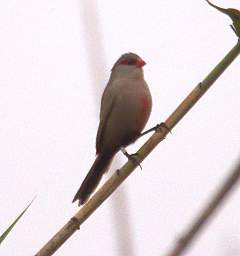 |
| Lesser Flamingos | Cape Sparrow | Common Waxbill |
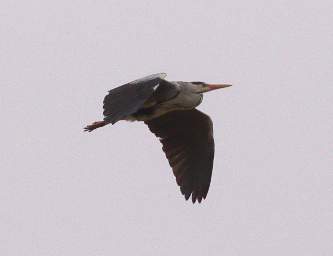 |
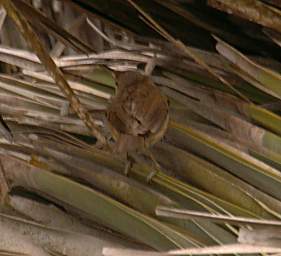 |
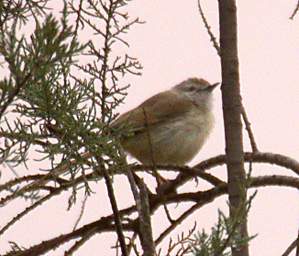 |
| Xxx Grey Heron | Bird Xxx | Xxx Chat Wheatear |
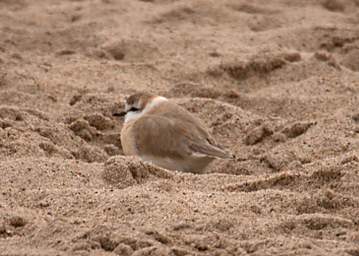 |
 |
| White Fronted Plover | |
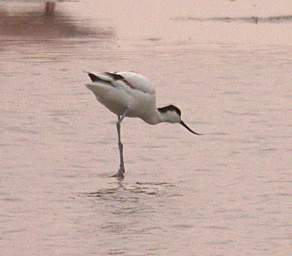 |
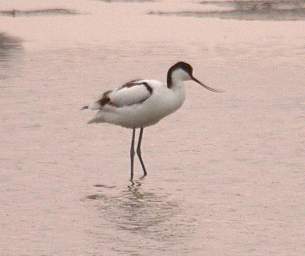 |
| Swakop Bird Pied Avocet | |
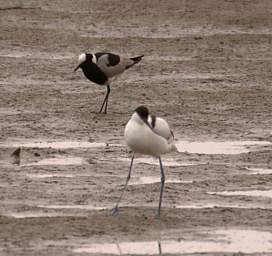 |
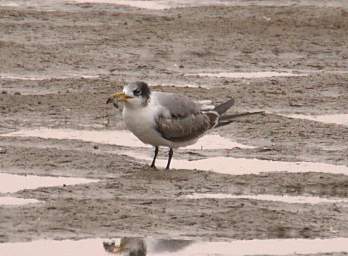 |
| Blacksmith Lapwing and Pied Avocet | Swift Tern |
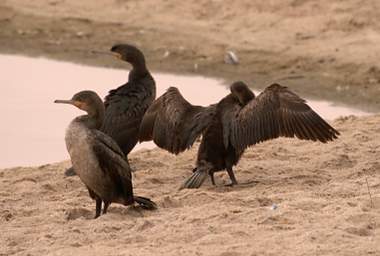 |
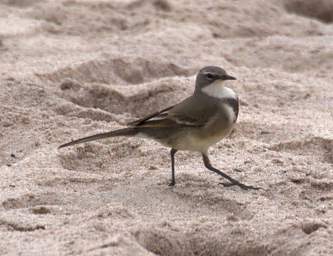 |
| White Breasted Cormorants | Xxx Mountain Wagtail |
 |
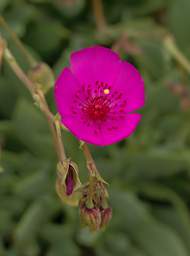 |
| Flower Pink Xxx | Flower Pink Xxx |
Then we headed up the beach towards town, where people were busy surf-casting, riding super-fat tired bicycles, beachcombing, and just relaxing -- but not much sun bathing!
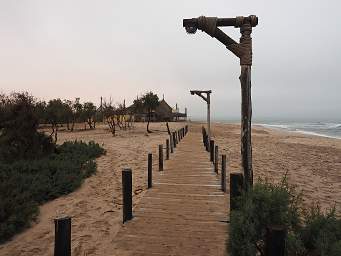 |
 |
| Beach Boardwalk in Swakopmund | Beach Bicycle |
When we got to the Swakopmund Acquarium we decided to check it out. They had these nice littly raised cubbies next to porthole type windows into the aquarium, where you could sit and observe comfortably. Dona settled right in.
 |
| Tunnel in the Swakopmund Acquarium |
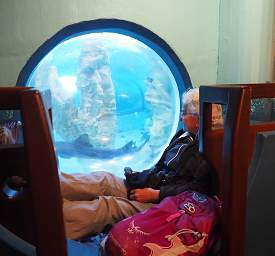 |
| Dona in a Cozy Seat at the Swakopmund Acquarium |
I watched a couple of fishermen surf-casting; they were having some success. I thought my brother-in-law Bob Fawcett would have been right at home alongside them. It didn't seem like much fun to me; I'm not very good at standing around in the cool damp waiting for a fish to bite; I'd much prefer actively working my way up or down a river. But hey, they were enjoying it, and that's what matters in this case.
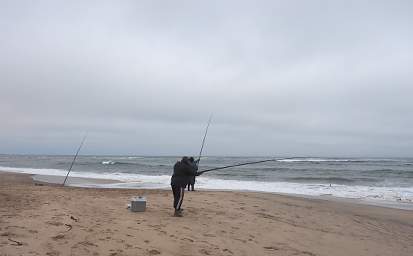 |
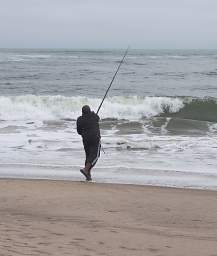 |
| Fishermen Surfcasting on the Swakopmund Beach | |
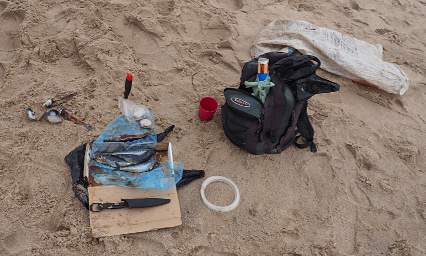 |
| Fishing Bait |
 |
| Swakopmund From Pier |
The next day we packed up and headed further south and further inland. I was not unhappy to leave Swakopmund behind. We were delighted to be heading to the Namib Naukluft, and more of the Namib desert. (Next)